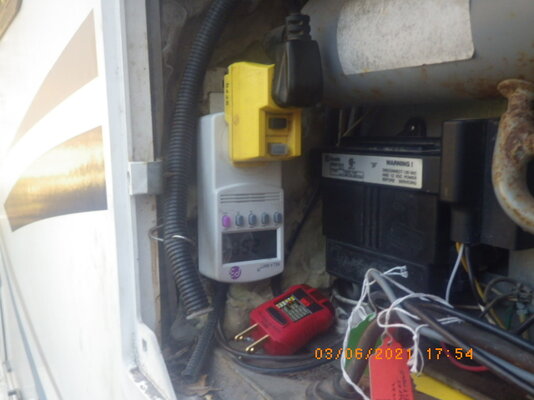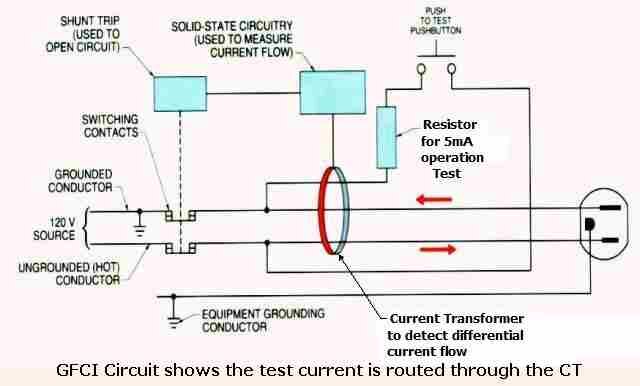DonTom
Well-known member
Today, I did some experimentation at my outlet that goes to my Dometic RM 2652 RV refrigerator.
The only outlet in my entire RV without GFI protection is in the refrigerator compartment. Sounds reasonable, because people are not expected to use this outlet for anything else. But read on.
As Gary mentioned in a different thread, a common problem is for the 120 VAC heater element to short to the metal grounded tube and cause one BIG ground fault that will NORMALLLY trip GFI. This recently happened to me while I was running my generator. While there was a dead short (0.0 ohms) from the outer shell of the 120 VAC heater element to the tube, my generator would still run for 15 seconds and shut down with an error code that didn't make a lot of sense. Also covered in the section.
But the 20 amp circuit breaker, in the generator did not trip. Obvious reason. The AC path between the K2 (propane/AC switching relay) and J7 (to the heater element) on the refrigerator control board is just a thin trace. No way is it going to handle above 20 amps for long and it will melt way before the generator CB will trip.
However, if you're at an RV park with GFI, the park GFI should trip in time to save the control board. But what if you're running your generator? I doubt many switch to gas when they run their generator. I leave my refrigerator on "AUTO" at all times. I assume most others do too, who have a model similar to my refrigerator.
So then I thought about this. While GFI is usually for people protection and not for equipment protection, it will trip VERY fast at the first sign of a short in an RV when the heater element shorts to the metal tube it is in. This should save the refrigerator control board for those who don't want to re-solder a trace. And that board is rather difficult to solder on (you may ask me how I know). I ended up soldering a wire wrapped around J7 and the other end at the K2 relay.
These can easily be added, see my yellow thingy below. No need to change the outlet. The KW meter will be removed, that was just part of my testing, but the GFI protection stays in.
I switched back and fourth many times between propane and 120 VAC (includes generator). There was no false tripping at all.
-Don- Auburn, CA
The only outlet in my entire RV without GFI protection is in the refrigerator compartment. Sounds reasonable, because people are not expected to use this outlet for anything else. But read on.
As Gary mentioned in a different thread, a common problem is for the 120 VAC heater element to short to the metal grounded tube and cause one BIG ground fault that will NORMALLLY trip GFI. This recently happened to me while I was running my generator. While there was a dead short (0.0 ohms) from the outer shell of the 120 VAC heater element to the tube, my generator would still run for 15 seconds and shut down with an error code that didn't make a lot of sense. Also covered in the section.
But the 20 amp circuit breaker, in the generator did not trip. Obvious reason. The AC path between the K2 (propane/AC switching relay) and J7 (to the heater element) on the refrigerator control board is just a thin trace. No way is it going to handle above 20 amps for long and it will melt way before the generator CB will trip.
However, if you're at an RV park with GFI, the park GFI should trip in time to save the control board. But what if you're running your generator? I doubt many switch to gas when they run their generator. I leave my refrigerator on "AUTO" at all times. I assume most others do too, who have a model similar to my refrigerator.
So then I thought about this. While GFI is usually for people protection and not for equipment protection, it will trip VERY fast at the first sign of a short in an RV when the heater element shorts to the metal tube it is in. This should save the refrigerator control board for those who don't want to re-solder a trace. And that board is rather difficult to solder on (you may ask me how I know). I ended up soldering a wire wrapped around J7 and the other end at the K2 relay.
These can easily be added, see my yellow thingy below. No need to change the outlet. The KW meter will be removed, that was just part of my testing, but the GFI protection stays in.
I switched back and fourth many times between propane and 120 VAC (includes generator). There was no false tripping at all.
-Don- Auburn, CA


